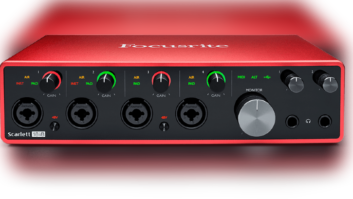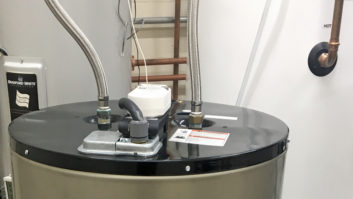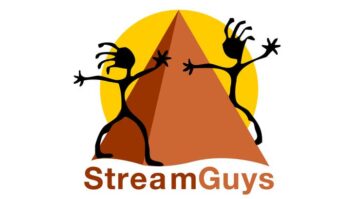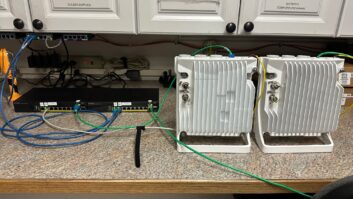Is it possible to produce professional audio without blowing your entire engineering budget for the year?
I recently tried several audio production applications that cost little to nothing. I narrowed our search to eight contenders and asked a team of production engineers, using demos of these programs, to produce spots.
In the July 13and Sept. 7 issues of Radio World we looked at the first five. Here are three more, and some concluding thoughts.
(click thumbnail)
Audacity’s editing capabilities are nowhere near as easy or as precise as other programs tested.

Free — Audacity
I feel almost stupid complaining about a free download, but Audacity is truly a case of getting what you pay for.
Its layout is similar to NCH Mixpad, mentioned last time. While it did allow for more editing without an additional program, the editing was nowhere near as easy or precise as the others. In fact, any cuts in an audio track automatically rippled; meaning the audio to the right of the portion being removed is butt-spliced to the audio to the left of the edit. There’s no way to defeat this.
There’s no support for VST or DirectX plug-ins either; no way to record additional audio onto existing tracks and MP3 encoding requires a separate download. Info: audacity.sourceforge.net/
Free — IK Multimedia Sample Tank
(click thumbnail)
Much more of a sampler than an editor, Sample Tank is a lot of fun to use though difficult to download and configure.

Let’s say you’ve already got an audio editor but you’re looking for something just to create music or some fun “zingers.” Sample Tank is a free, downloadable software sampler and VST instrument. It operates as a standalone application or as a VST plug-in.
My biggest complaint was a rather convoluted download process. Registration with IK Multimedia is required before downloading (sort of like having to join Sony Acid Planet to get Acid Express). Then the user is prompted to download the Authorization Manager, a separate program which keeps track of what IK programs you have and whether they are properly registered. Sample Tank cannot be used until the Authorization Manager says it’s okay. This requires a trip to the IK website to find the User Area, and the serial number for Sample Tank, which must then be manually entered into the Authorization Manager.
But wait! You’re not finished! The enormous sample library is another separate download, and here’s the kicker; you only have 30 days from the day you download Sample Tank to get the free library. Otherwise, you have to purchase it.
Beyond that, it was a lot of fun to use. It’s best used with a MIDI keyboard, as trying to trigger the notes using the on-screen keyboard and a mouse, or using the PC keyboard, was awkward at best. Info: www.ikmultimedia.com/sampletankfree/features/
$49/$39 — Goldwave/Multiquence
(click thumbnail)
Goldwave is attractive and relatively easy to use but its Multiquence partner is more problematic.

Goldwave Inc. offers two separate programs that can work together, much like NCH Mixpad and Wavepad. Goldwave is a stereo-only sound editor that is essentially a Swiss Army knife for audio.
It includes several built-in effects from basic EQ and filters to noise reduction and even some very interesting effects like Mechanize, Doppler and Censor (for easily replacing offensive audio with the tone of your choice). It’s attractive and relatively easy to use.
Multiquence is a basic multitrack recorder and editor. It also has basic video recording and editing capability. Dragging and dropping audio clips (called “sections” here) was pretty simple. Editing is rudimentary. For more surgical editing, Multiquence can be configured to access the WAV editor of your choice, such as Goldwave.
The biggest disappointment — and this is significant — is that it is impossible to EQ or otherwise adjust the processing of a clip of audio in real time. To EQ a track, for example, the user must first select the track, then select the effect from the toolbar. This brings up a pop-up window to make the adjustments. Here’s the catch: While this window is open, it is impossible to play the audio; so there’s no way to adjust by ear! This limitation also applies to third-party plug-ins. That’s a deal-breaker for me. Info: www.goldwave.com
Conclusion
Also Reviewed:
Part 1: Ableton Live Intro; Sony Acid Express
Part 2: Acoustica Mixcraft, NCH Mixpad and n-Track Studio 6.
So what’s the best value among our contenders?
Strictly based on price, you can’t beat Sony Acid Express (it’s free!). The lack of effects and processing, however, might be off-putting for some.
I thought Acoustica Mixcraft ($69.95) had the most value in terms of the all-in-one solution you get for the low price.
If you don’t need to produce music, n-Track Studio ($64) or NCH Mixpad ($69.95) will get the job done, but be prepared to sacrifice features.
Bottom line: Is it possible to produce air quality audio for under $100? Absolutely. Granted, there were trade-offs; and low price often means entry level. If you need audio production software on a tight budget, you owe it to yourself and your station to do the research, download the demos and see for yourself whether these options work for you.
Special thanks to WAWZ(FM)’s David A. Dein and Izzy Knight and WNYZ(LP)’s Abel Sanchez for their contributions to these articles.
Curt Yengst, CSRE, is assistant engineer for WAWZ(FM) in Zarephath, N.J . What’s your favorite production software and why? Write to [email protected].





